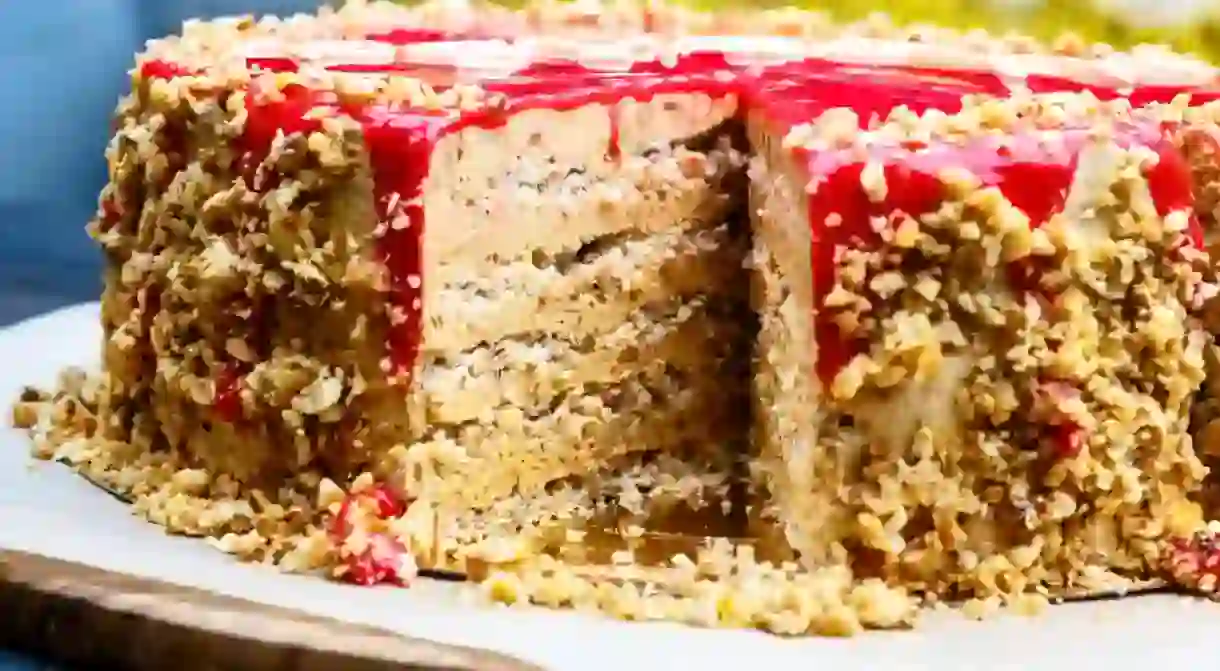11 Mouthwatering Russian Cakes You Should Try

Desserts have always held a special place at the Russian table, and the nation’s cuisine has sweet tooths covered with its delicious assortment of cakes. Many of these cakes are dense with sugary sour-cream and laden with nuts and fruit. All of them are rich and decadent. Try any one of these eleven cakes, and it will be hard not to come back for seconds.
Moscow Cake
A new addition to Russia’s cake repertoire, the Moskva was made in 2015, and can now be found throughout the capital. Always glazed with a red icing, the cake is a moist sponge cake layered with walnuts and condensed milk. A true cake of the people, it was given its name after more than 200,000 Moscovites voted on it in an initiative that encouraged Moscow residents to take part in city governance. The cake won the right to represent Russia’s capital over 80 other cake recipes, beating a chocolate and cranberry biscuit cake, and a pistachio and cherry mousse cake.
Kiev Cake
Manufactured in the Soviet Union since the mid-1950s, this cake soon became a popular treat across the USSR. It is made with up to five different types of nuts that are scattered across the layers of sponge, including hazelnuts and cashews, which were both uncommon in Soviet cooking. Despite chronic food shortages, the Kiev cake is indicative of the indulgent cake style of the mid-twentieth century – the original recipe used 600 grams of custard and 400 grams of egg whites for one cake.

Prague Cake
This is as dense chocolatey cake, loaded with condensed milk and seven eggs. It also has no connection to the Czech Republic whatsoever. Made by a pastry chef from the renowned Prague restaurant in Moscow during the 1970s, the cake takes its name from the restaurant. The Prague restaurant was celebrated for its Soviet glamour and was considered the height of cuisine culture at the time. This decadent chocolate cake was one of the most coveted desserts it made.
Bird’s Milk Cake
A symbol of Soviet austerity, Bird’s Milk Cake was created during Soviet times as a reaction to the indulgent cakes of the 1950s and another triumph of the Prague restaurant. A lot of trial and error went into creating the mousse filling as a team of pastry chefs toiled for six months to get the consistency right by mixing gelatin and agar with condensed milk. Also known as Ptichye Moloko, it is a spongy biscuit layered with mousse or a soufflé (or nowadays even marshmallows) and covered with a chocolate glaze. Popular throughout the Soviet era, it remains a favourite treat among Russians and those who live in post-Soviet states.

Muraveynik
This cake is also referred to as the anthill cake, due to its mound-like shape. Much like the chocolate salami log, this treat can be whipped up out of broken biscuits or old sponge cake if you can’t be bothered to make the sour-cream-laden cookie dough. Biscuits are mixed up with a chocolatey buttercream and toasted walnuts and then piled up into the hill shape. Sprinkle with poppy seeds or shaved chocolate for the perfect afternoon tea treat.
Medovik Cake
Russian honey cake is a moorish treat and another layered cake, this time slathered with sweetened sour cream or crème fraîche if you prefer something lighter. The cake pre-dates Soviet times and was made by the personal chef of Tsar Alexander I. Honey was a traditional sweetener in Russian cooking and is still added to the biscuit dough along with condensed milk, which gives it that delicious caramel taste.

Polyot Cake
This is a drool-worthy meringue and buttercream cake that appeared in the Soviet Union in the 1950s. Its decadence, like the Kiev cake, is indicative of the indulgent desserts that were popular at the time. Traditionally the meringue is made from ground peas; however, it is often replaced with cashews or hazelnuts nowadays. Although you’ll probably want to eat it as often as possible, its traditionally wheeled out for festivities and special occasions.
Skazka Cake
Skazka, translating to ‘fairy tale’, was one of the most affordable cakes during Soviet times. It is also, comparatively, easy to make and so it is as popular today as it was in the USSR. Generally shaped like a log, biscuits are soaked in an orange liqueur, or a cognac, and then decorated elaborately with icing flowers and candied fruits.

Napoleon Cake
This cake takes its name from a Napoleon-hat-shaped batch of layered pastries made in 1912 as part of centennial celebrations of Russia’s victory over France in the Patriotic War. Layers of pastry are slathered with custard, then sprinkled with pastry crumbs that symbolise the bitter winter that helped Russia defeat Napoleon. While many cakes were made during Soviet times, the Napoleon cake didn’t fare well during food shortages. As a result, it became a cake to bake at home, where people were free to experiment with ingredients.
Pancho
Another recent addition to Russia’s cakes, Pancho is based on housewife recipes. It may look like a bit of a melting mess, but its odd shape is part of the appeal and has earnt the dessert the nickname of ‘volcano cake’. Chocolate and vanilla layers are soaked in vanilla cream and loaded with nuts and cherries, which are then covered in a chocolate glaze. If you want a denser cake, use sweetened sour cream to soak the sponge layers in.

Lemonnik
This is more of a slice than a cake and is a lot lighter than many of the sour cream and butter-heavy baked sweets and desserts. Perfect for summertime, the lemon filling gives the dish a bit of a tart kick. It is made with a shortcrust pastry that has been covered in a layer of minced lemons mixed with a bit of sugar.













